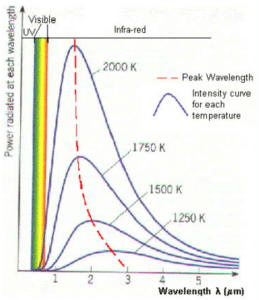Black body radiation and planck’s radiation law
Another phenomenon that classical physics could not explain was the emission of radiation by a black body. A black body is an object capable of absorbing all the radiation that comes to it without reflecting anything. The intensity of the radiation emitted by a black body varies with the wavelength according to a characteristic curve that has a maximum dependent on body temperature.
According to classical theory, the intensity of the radiation emitted by the black body should increase, as the wavelength decreases, becoming infinite, a behavior that lacks physical sense.
When a body is heated, it emits radiation. The nature of the radiation depends upon the temperature. At low temperatures, a body emits radiation which is the principal of long wavelengths in the invisible infrared region. At high temperatures, the proportion of shorter wavelength radiation increases. Furthermore, the amount of emitted radiation is different for different wavelengths. It is of interest to see how the energy is distributed among different wavelengths at various temperatures.
For example, when the platinum wire is heated, it appears dull red at about 500 C°, changes to cherry red at 900 c°, becomes orange-red at 1100 c, yellow at 1300 C° and finally white at about 1600 C°. This shows that as the temperature is increased, the radiation becomes richer in shorter wavelengths.
In order to understand the distribution of radiation emitted from a hot body. We consider a non-reflecting object such as a solid that has a hollow cavity within it. It has a small hole and the radiation can enter or escape only through this hole. The inside is blackened with soot to make it as good an absorber and as bad a reflector as possible. The small hole appears black because the radiation that enters is reflected from the inside walls many times and is partly absorbed in each reflection until none remains. Such a body is termed a black body and has the property to absorb all the radiation from entering it. A black body is both an ideal absorber and an ideal radiator.
Intensity Distribution Diagram
Lummer and Pringsheim measured the intensity of emitted energy with wavelength radiated from a black body at different temperatures. The amount of radiation emitted with different wavelengths is shown in the form of energy distribution curves for each temperature in the figure below.

These curves reveal the following interesting facts.
- At a given temperature, the energy is not uniformly distributed in the radiation spectrum of the body.
- At a given temperature T, the emitted energy has a maximum value for a certain wavelength λmax and the product λmax ×T remains constant.
λmax ×T=Constant …..(1)
The value of the constant is about 2.9 × 10-3 m K. This equation means that as T increases, λ shifts to the shorter wavelength.
For all wavelengths, an increase in temperature causes an increase in energy emission. The radiation intensity increases with an increase in wavelengths and at a particular wavelength λmax , it has a maximum value. With a further increase in wavelength, the intensity of radiation decreases.
The area under each curve represents the total energy (E) radiated over all wavelengths at a particular temperature. It is found that area is directly proportional to the fourth power of kelvin temperature T. Thus
E ∝ T4 OR E=σT4 ………..(2)
Where σ is called Stephen’s constant. Its value is 5.67 ×10-6 Wm2k-4 and the above relation is known as Stephen Boltzmann law.
Planck’s radiation law and Assumption
The electromagnetic wave theory of radiation cannot explain the energy distribution along the intensity wavelengths curves. The successful attempts to explain the shape of energy distribution curves gave rise to a new and non-classical view of electromagnetic radiation. In 1900, Max plank founded a mathematical model resulting in an equation that describes the shape of observed curves exactly. He suggested that energy is radiated or absorbed in discrete packets, called quanta rather than as a continuous wave. Each quantum is associated with radiation of a single frequency. The energy E of each quantum is proportional to the frequency f, and:
E = hf …….(3)
Here h is Plank’s constant. Its value is 6.63×10 -34 J s. This fundamental constant is important in physics as the constant c, the speed of light in a vacuum.
Max Planck received the Nobel prize in physics in 1918 for his discovery of energy quanta.
Black body radiation (video)
manjesh2318@gmail.com